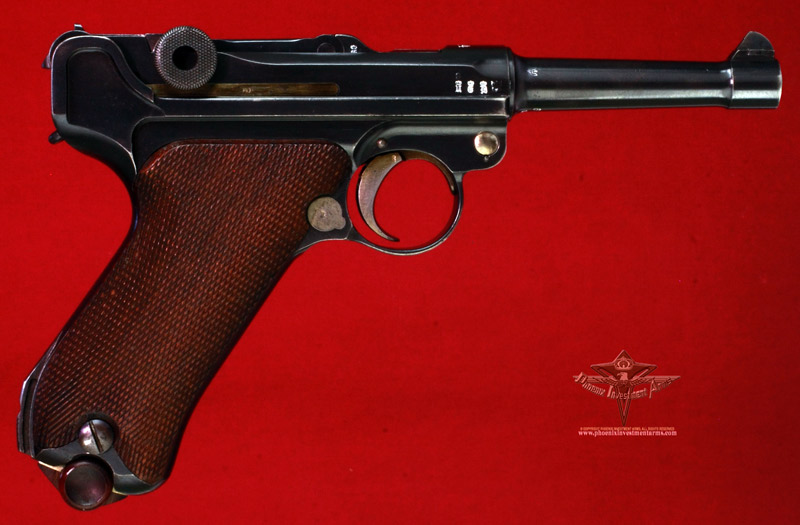

1914 Erfurt Imperial Luger SOLD
align="center">PHOENIX INVESTMENT ARMS -
PREMIUM COLLECTOR LUGERS
Genuine German
Luger - Largest Variety of Lugers Offered
Home | Post WWI DWM | Erfurt Lugers | Mauser | Simson Suhl | Krieghoff | Vickers | Swiss Bern | Other Guns
Bottom of Page
|
|
|
This is a 1914 dated early Imperial Luger manufactured by the Royal Arsenal at Erfurt. The 1914 Chamber date is the year of production by Erfurt, in this case very early in the war. This is a 9mm Parabellum with a 100mm barrel. Just like it came from the battlefield of WWI. (3001) |
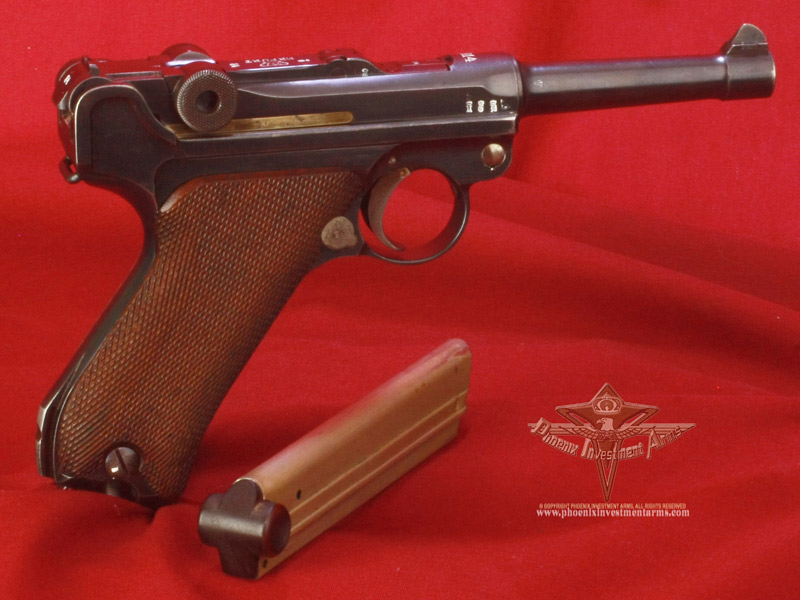 |
|
NOTE: Photographs taken today with the high mega-pixel camera show more than we sometimes can see with the human eye. Magnified close-ups show us tool marks and natural surface conditions that one normally doesn't see in the ordinary handling of the weapon. Photographs are copyrighted, all rights reserved, any extraction, reproduction or display of gun pictures without the express consent of the Phoenix Investment Arms is strictly prohibited. Thank you for your cooperation. Please visit Legal (tabbed) for Conditions of Sale. |
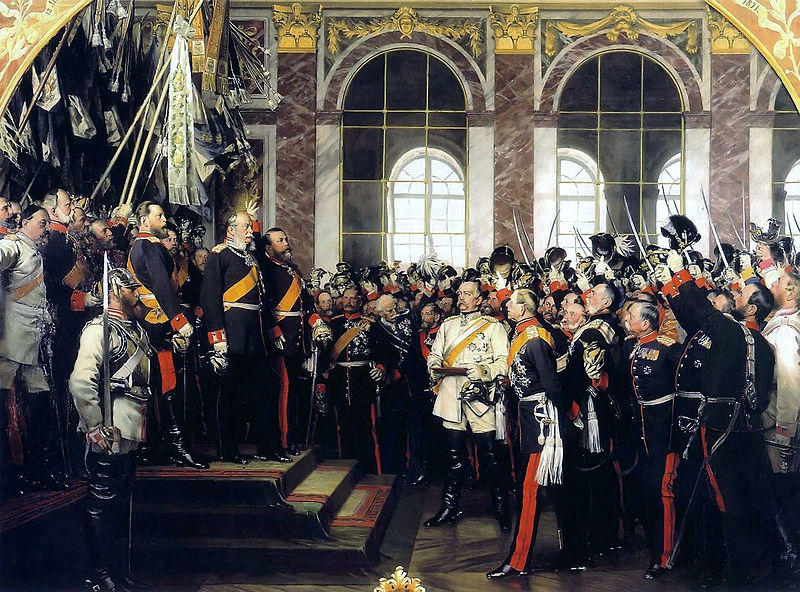 |
|
Under the 1878 Treaty of Berlin, Austria-Hungary received the mandate to occupy and administer the Ottoman Vilayet of Bosnia while the Ottoman Empire retained official sovereignty. Under this same treaty, the Great Powers (Austria-Hungary, Britain, France, Germany, Italy, the Ottoman Empire, and Russian Empire) gave official recognition to the Principality of Serbia as a fully sovereign state, which four years later transformed into a kingdom under Prince Milan IV Obrenović who thus became King Milan I Obrenović. Serbia's monarchs at the time from the royal House of Obrenović that maintained close relations with Austria-Hungary were content to reign within the borders set by the treaty. |
|
|
|
This 1912 Luger is characterized by the 9mm 4" (100mm) barrel and was built without a hold open and utilized the long sear. The rear sight is "V" cut fixed and front dovetailed sight and the frame has the stock lug and hold open device. This model still has the long sear which prevented the gun from being cocked when the thumb safety was engaged. |
|
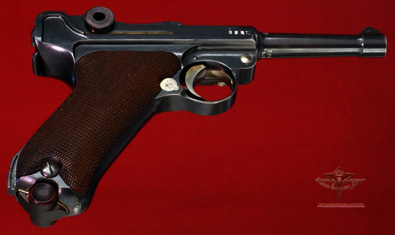 |
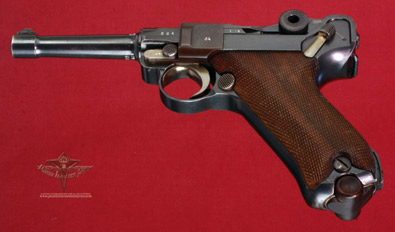 |
|
This model of the Luger was produced from
1908 until 1914 for the German Military when the model was changed to
include the hold open and add the stock lug. The extractor is
marked "Geladen" (loaded) and the thumb safety is marked "Gesichert"
(safe). |
|
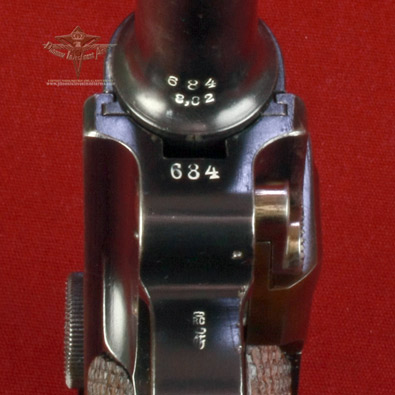 |
 |
|
On the left is the frame and
barrel matching serial numbers. Military Lugers were numbered
1-10000 and then 1a-10000a, 1b-1000b, and so on. To properly identify your
Luger always use the full serial number with the alphabet identifier.
Above Right: The magazine is rolled and crimped steel with the wooden bottom that is proofed at the top and bottom and has the three digit serial number. All-matching. |
|
 |
|
 |
|
|
The right side of the receiver displays all the Imperial Army acceptance stamps. Erfurts were always very heavily proofed; a delight to study. In 1914 the Erfurt factory stopped production of the 4" barrel and focused on the artillery model (8") and the DWM factory concentrated on the 4" production. This makes the 1914 Erfurt a rather difficult to find Parabellum. The experiment proved unsuccessful as most of the young worked at Erfurt were being drafted and production never reach that of DWM with an aged craftsman workforce. |
|
|
Under the 1878 Treaty of Berlin, Austria-Hungary received the mandate to occupy and administer the Ottoman Vilayet of Bosnia while the Ottoman Empire retained official sovereignty. Under this same treaty, the Great Powers (Austria-Hungary, Britain, France, Germany, Italy, the Ottoman Empire, and Russian Empire) gave official recognition to the Principality of Serbia as a fully sovereign state, which four years later transformed into a kingdom under Prince Milan IV Obrenović who thus became King Milan I Obrenović. Serbia's monarchs at the time from the royal House of Obrenović that maintained close relations with Austria-Hungary were content to reign within the borders set by the treaty. |
|
|
|
This changed in May 1903 when Serbian military officers led by Dragutin Dimitrijević stormed the Serbian Royal Palace. After a fierce battle in the dark the attackers captured General Laza Petrović, head of the Palace Guard, and forced him to reveal the hiding place of King Alexander I Obrenović and his wife Queen Draga. The King and Queen opened the door from their hiding place. The King was shot thirty times; the Queen eighteen. The royal corpses were then stripped and brutally sabred. The attackers threw the corpses of King Alexander and Queen Draga out of a palace window, ending any threat that loyalists would mount a counterattack. General Petrović was then killed too (Vojislav Tankosić organized the murders of Queen Draga's brothers; Dimitrijević and Tankosić in 1913–1914) and figured prominently in the plot to assassinate Franz Ferdinand. The conspirators installed Peter I of the House of Karađorđević as the new King. |
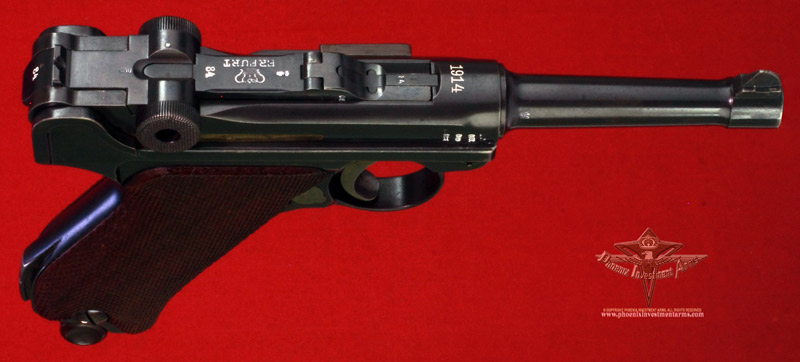 |
|
The Erfurt's are the most proofed models of
Parabellums. There are
inspector marks all over the weapon in a variety of crowed stamps. Proof marks are well struck and clearly
visible. |
|
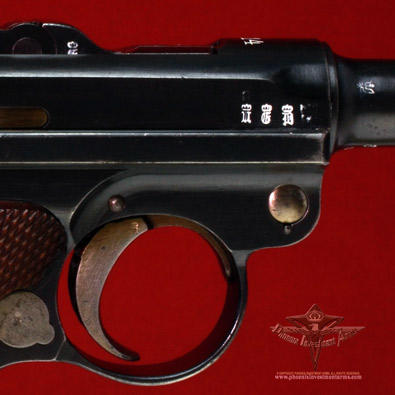 |
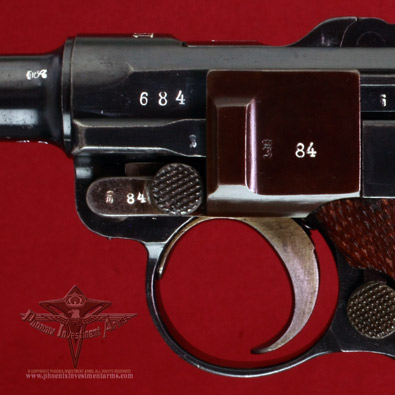 |
| The crown marks with letters are the Erfurt Royal Arsenal and the proof on the left top barrel and side of the receiver is the Erfurt Military Acceptance stamp. | |
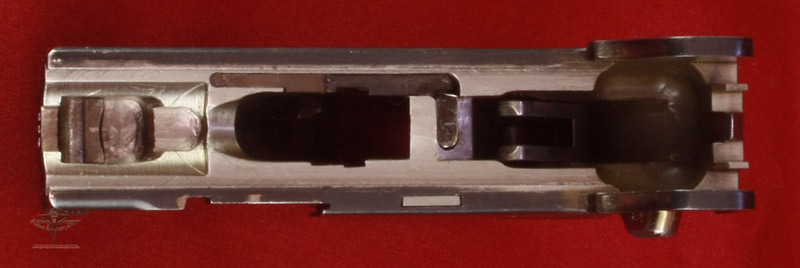 |
|
In the initial contract to save money the German Government decided not
to mortise the frame for the hold open spring which they believed saved
them costs. In the field this proved a poor decision because they
shooter didn't know when the gun was empty and had to go through the
entire charging stroke to reload. In 1914 this order was amended, new guns had hold-opens
and old ones were refitted which accounts for the "pin" in the right
rail and a Crown RC. This Parabellum was |
|
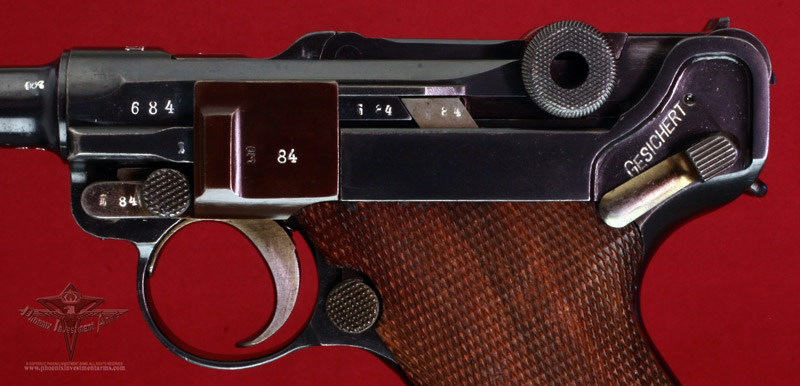 |
|
The number of and the proofs themselves are outstanding. These early war guns were made just like the commercial models with craftsman and all the fine tooling. In the photographs the side plate has a plumb color. This is caused by the temperature of the blueing salts when submerged and this color is achieve when the contents are too hot. The Crown proof on the side plate and matching number with a minimal wear pattern suggests it was the original. |
|
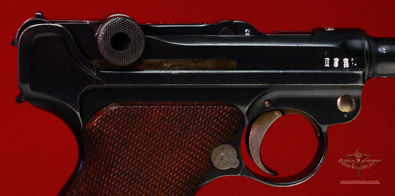 |
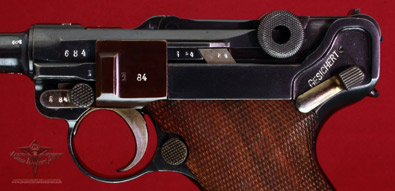 |
 |
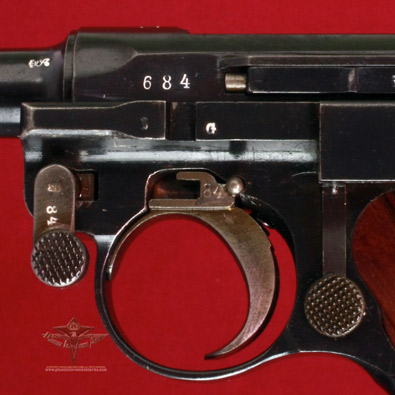 |
Serial number placement is in the
military ("exposed") style; displayed on the left side of the
receiver, the side plate, the locking bolt, the sear bar safety, the
extractor, the forward toggle link, the front of the frame, under the
barrel, and on the side of the trigger. This example has
all matching numbers. |
|
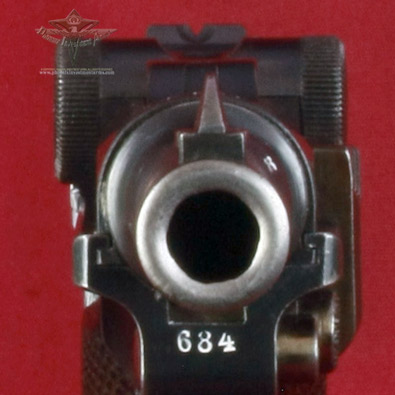 |
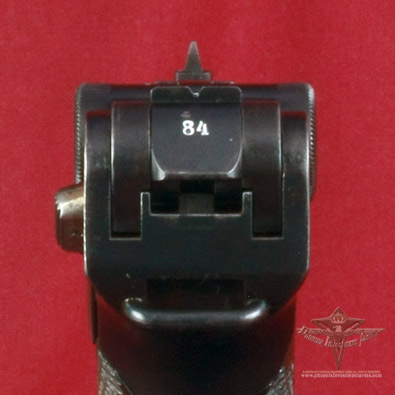 |
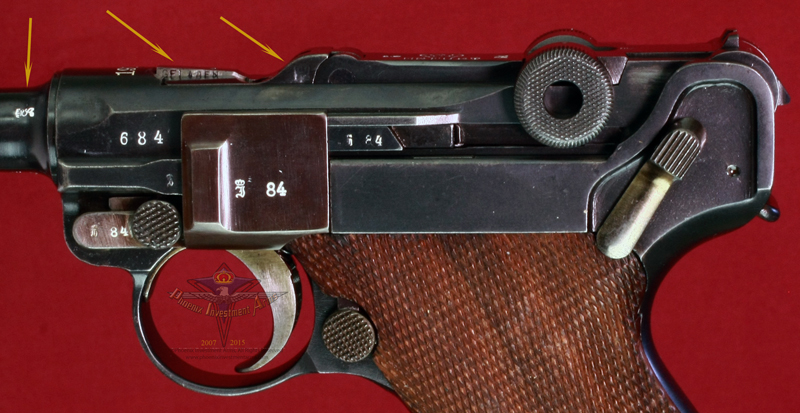 |
|
| On the barrel is the Crown S military acceptance of the over-load test load, then the Geladen (Loaded), proof on breach block. The small Crown proofs extend all over the Parabellum and the last two numbers of the serial number on the small parts. | |
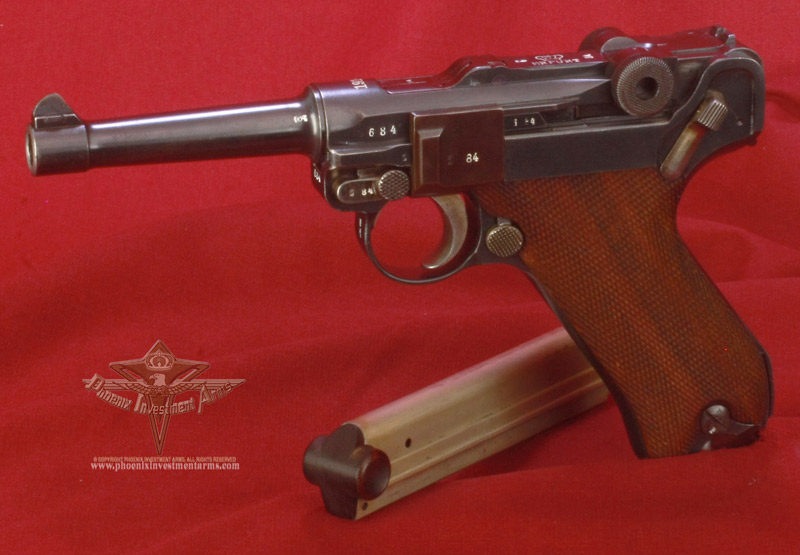 |
|
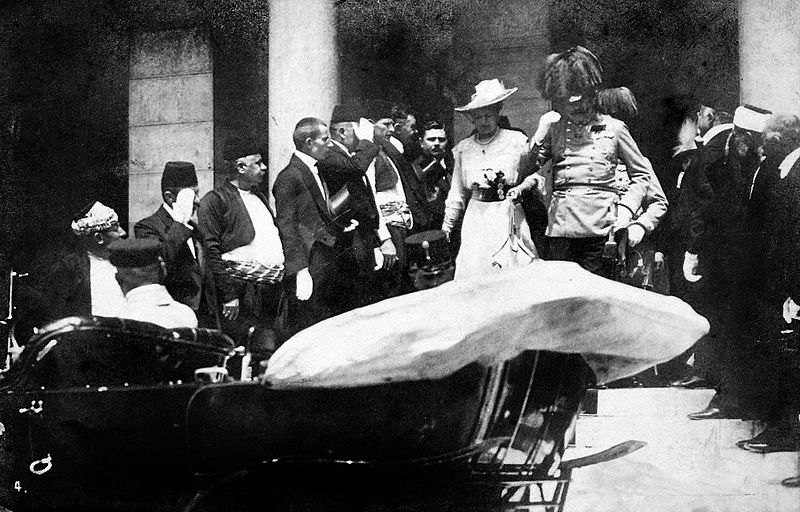 |
|
Among the very last pictures of Archduke Ferdinand unknowing that assassins lay in wait along his path. The first attempt was a bomb tossed into this carriage but it hit the rear cover and bounced under the following carriage destroying that and killing or wounding the occupants. |
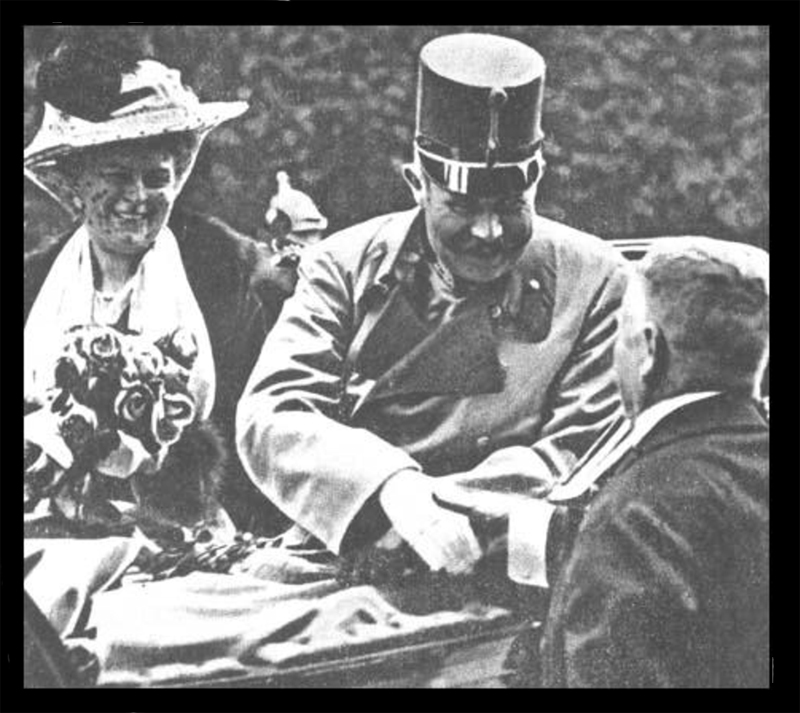 |
|
A Serbian terrorist group, the Black Hand, resolved to assassinate Franz Ferdinand during his visit to Sarajevo on 28 June 1914, thereby stalling his proposed reforms. Earlier in the day Ferdinand's car had also been fired at by a hand grenade, causing him to complain angrily upon his arrival at the city hall. Archduke Franz Ferdinand interrupting the Mayor's welcome speech at Sarajevo's city hall, 28 June 1914."What is the good of your speeches? I come to Sarajevo on a visit, and I get bombs thrown at me. It is outrageous!" While riding in the motorcade through the streets of Sarajevo on 28 June, Franz Ferdinand and his wife Sophie were shot and killed by Gavrilo Princip, a Bosnian member of the Black Hand; He first shot Sophie in the abdomen causing her severe pain and then shot Ferdinand in the chest with hist pistol. The assassination provided Austria-Hungary with an excuse to take action against Serbia. During July 1914 the situation escalated, pulling in the major European powers via the complex alliance relationships each had struck up with one another. The result was world war. BELOW The trial of the Muslim Black Hand society which Gavrilo Princip, center, was too young for the death penalty and died under harsh prison conditions. |
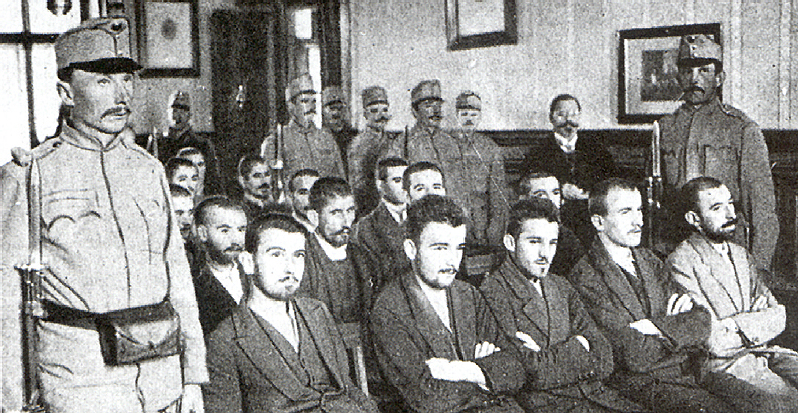 |
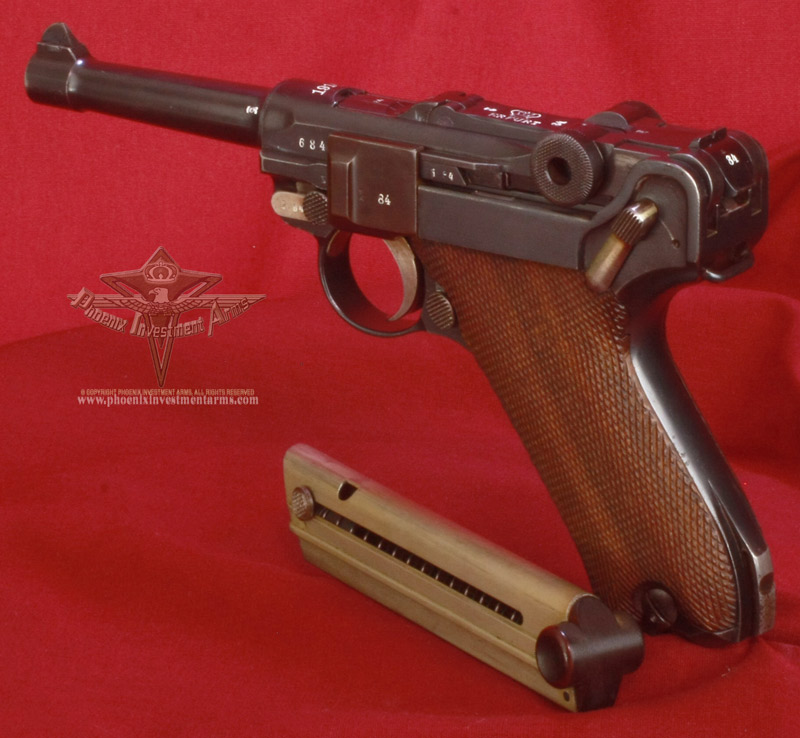 |
|
|
Everyone needs one Erfurt in their
collection just to study proof marks. This is a basic collectors gun
that has all the study proofs you could ask for. This weapon
is designated as a Curios and Relic (C&R) and be sent to those licensed
persons. If you have Sam Costanzo's
World of Lugers Proof Marks you can spend days looking up all the proofs
this gun has. Every Luger can tell you a story if you're willing to
explore and learn from it. |
|
.jpg) |
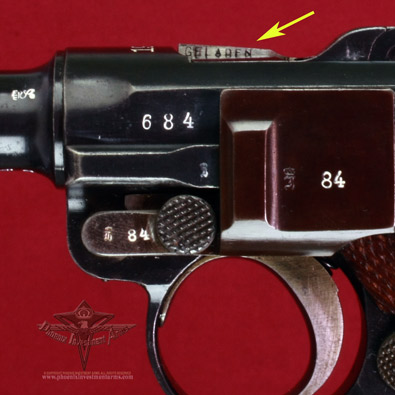 |
|
The abundance of proofs are illustrated by the pictures above with the Small Crown letter proofs on the small parts. The extractor is marked "GELADEN" (Loaded) and is raised whenever a round is in the chamber. This notifies the shooter both tactiley and visually that the Parabellum is loaded. |
|

|
|
|
The above shot gives you the 1914 date, the last year without the mortise on the front of the frame for the artillery barrel and the two proofs on the barrel with the Final Acceptance Stamp and Crown R/C for an factory call back for most likely addition of the hold open. Plus the second toggle Erfurt Logo |
|
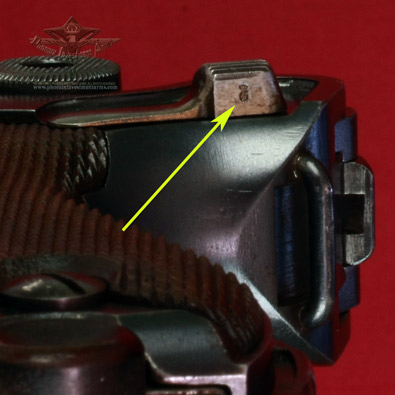 |
|
|
The thumb safety are Type III with the last two digits of the serial number and proofs. RIGHT: The tiny proofs extend to the extractor and without magnification are hard to find. |
|
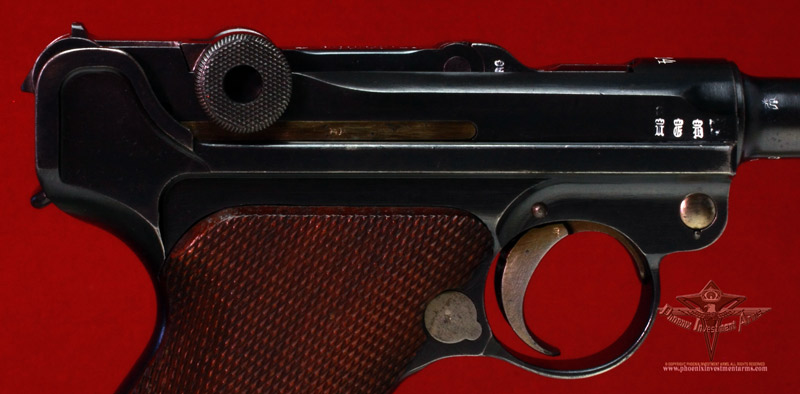 |
|
| Erfurts are proofed on the back of the magazine release, the trigger, the extractor, and breachbock in addition to the receiver and barrel. There is no revision of the maching for the hold open but it was mortised during production. This is a very difficult Luger to find, the 1914 100mm Luger was only produced in an estimated 7,000 models, less those lost to war. | |
|
|
|
 |
|
| This is one of the most impressive Erfurts that we have seen in 40 years of dealing in the Luger. Not the top of the thumb safety, the extractor, 1st and 2nd toggle link reveal the last two digits of the serial number. | |
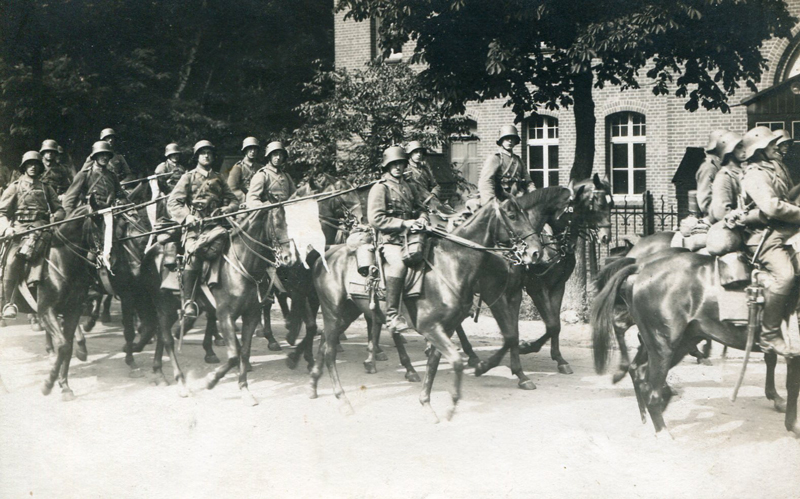 |
|
At the outbreak of WWI the German Army seemed reasonably equipped with the Luger Pistol. The DWM factory in Berlin moved to peak production by 1915 and were producing 700 Parabellums per day; however this didn't meet the requirements for the massive mobilization. |
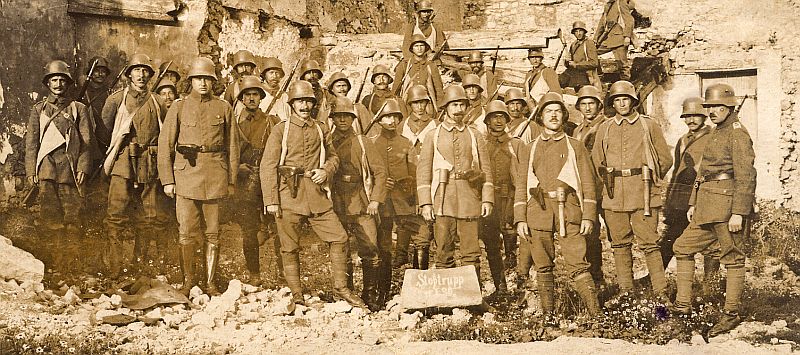 |
|
|
|
| Clean and well kept by its owner this Luger has the short sear a Crown RC indicating it was brought back to the arsenal for either repair or replacement of a part. The barrel is strong with clear lands and grooves. | |
|
|
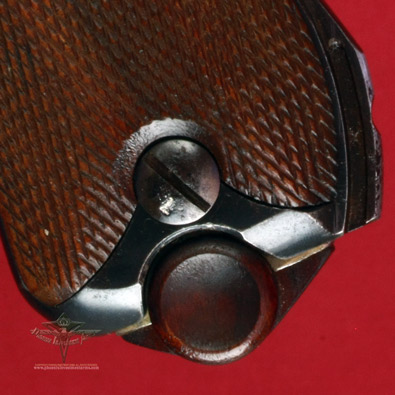 |
|
Original grips are finely cut diamond shaped checkering made from walnut or in some cases beech wood. Original grips were serial numbered to the gun and when installed by the Erfurt factory also proofed. Also in the above right picture you can see the Crown Letter proof on the screws, a characteristic of the early Erfurt. |
|
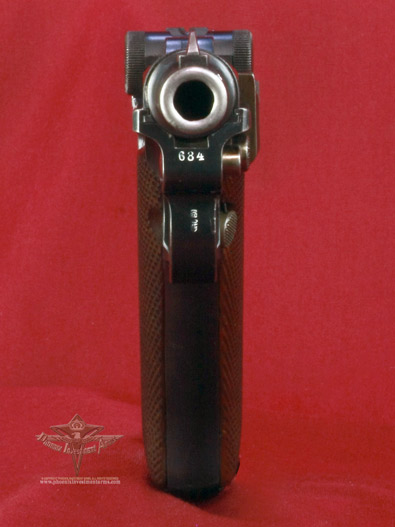 |
 |
Everyone needs one Erfurt in their
collection just to study proof marks. This is a basic collectors gun
that has all the study proofs you could ask for. This weapon
is designated as a Curios and Relic (C&R) and be sent to those licensed
persons. See
Kenyon, Lugers At Random Page 168 |
|
|
|
|
|
The Erfurt factory was originally located in Saarn and then moved to Erfurt under private ownership. It was then purchased by the Prussian government and produced huge quantities of weapons, estimated to exceed 800,000 before being dismantled by the Allies at the end of the WWI and the machinery then sold to Simson. The 1910 Erfurt Imperial Acceptance stamp was the Imperial Eagle with the cross of peace and the bar of justice, still heraldic in nature as an Imperial proof. The war destroyed vast quantities and these 90 yr old guns that have survived today are treasured in collections throughout the world. |
|
|
|
This is a excellent example of the hard to find early War 1914 dated Erfurt Imperial Parabellum and built by the Royal Erfurt Arsenal for the Imperial Army. The finish on this Luger is early war polished and rust blued making it distinctive from the latter war mass produced model. This is a handsome Erfurt that any collector would be proud to display. We reserve the right to sell any internet offering to a direct sale and do not warrant the availability of any firearm that does not have a physical deposit. Call for availability. This gun may be withdrawn without notice for in-store sale. Any questions or request for additional pictures email to josef@phoenixinvestmentarms.com. |
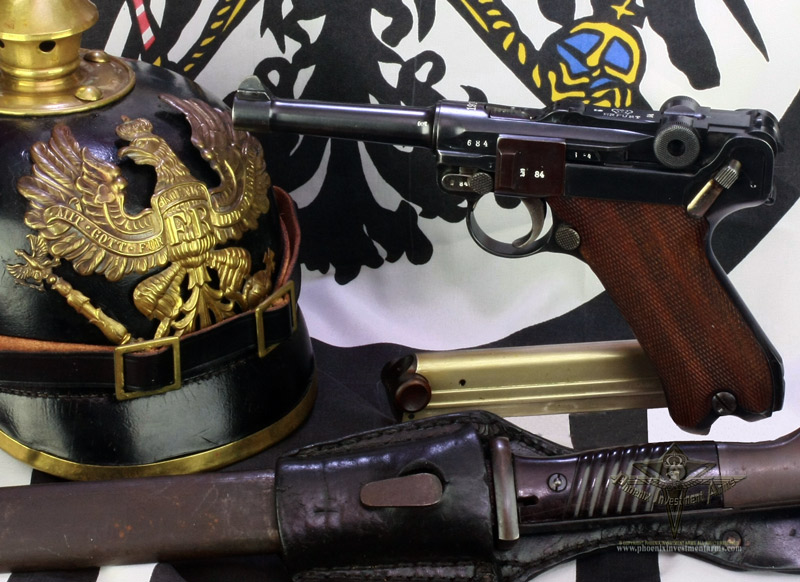 |
Home | New Additions | 1900-06 | WWI Imperial | Carbines | Artillery | Imperial Navy | Police Models | Archived Lugers | Accessories
Sell Your Gun | Notices | Good Info (C&R) | Ordering | Contact Us | Gun Shows | Legal Stuff | Testimonials | Notices | Holsters | Books
Top of Page
LAYAWAYS: Sometimes our "significant other" doesn't understand the beauty, craftsmanship and investment potential of one of these investor grade weapons. In these circumstances where discretion becomes the better part of valor we will accept layaways of up to one year with at least 20% down and some activity occurring monthly to insure that after one year the sale is completed. Cancellations of layaways forfeit 33% if done within two months, otherwise 100%. You can transfer a layaway to a consignment sale at any time. See "Legal" for exact terms. |
3 Day Return Policy We honor a three day return policy. We will answer any questions, send you any pictures, as detailed as you want, to insure that what we are showing you is what you want to see, before you buy it. See Legal. |
||
|